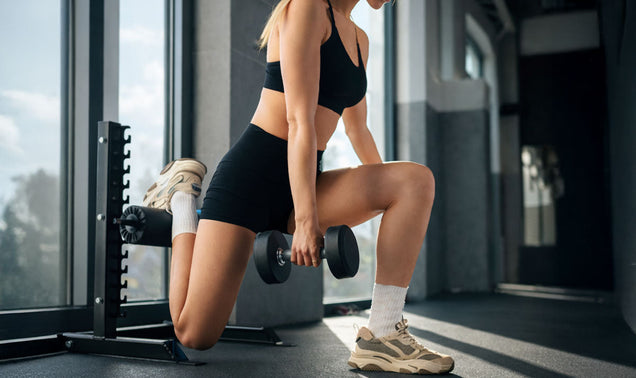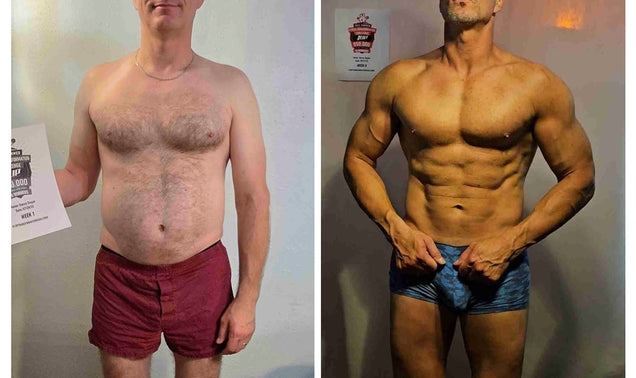How many times have you walked into the gym and seen somebody on the leg press loaded up with plates upon plates only to see them barely moving the sled up and down?
Probably more times than you can honestly remember.
After seeing these partial-rep phenoms, you’ve probably wondered:
- Are partial reps helpful?
- Should I try it?
- Do partial reps build muscle?
- Or, are they just trying to boost their ego and impress others at the gym?
Some die-hard gym bros swear by partial reps, while others say it is a complete waste of time, and that you should only use a full range of motion when lifting weights.
What’s the truth concerning partial reps vs full reps?
You’re about to find out!
What Are Partial Reps?
When discussing partial reps vs full reps, we are referring to the range of motion that your muscles go through during a single repetition of an exercise.
A “full rep” would be a repetition that starts with a muscle fully extended, bringing it into a fully flexed (contracted) position, and then bringing it back to full extension.
You can also view the range of motion from the perspective of the angle between two bones, also known as the joint angle.
When you flex a muscle, you decrease the angle between two limbs, and when you extend a muscle, you increase the joint angle.
To help illustrate this concept, let’s use a simple example -- the bicep curl.
When your arm is fully extended, the angle between the upper arm and the forearm is largest and the biceps is in the fully stretched position.
As you flex your bicep, the muscle fibers start to contract (shorten), decreasing the angle between your forearm and upper arm. When your biceps are fully contracted, the angle between the upper and lower arm bones is as small as possible. As you start to lower the weight, the muscle fibers of your biceps lengthen and the angle between the upper and lower arm bones increases until they are back at the fully lengthened position.
Therefore, a “partial rep” would be any rep that is not performed from full extension to full flexion back to full extension.
A common example of partial reps are “21s”, where you perform 7 partial reps from the bottom of a curl to the midpoint, then another 7 reps from the midpoint to the top of the curl, and finish with a set of 7 reps using a full range of motion.
Are Partial Reps Beneficial?
The implementation of partial reps is nothing new to the world of resistance training. “21s”, box squats, and rack pulls are all examples of exercises that use a partial range of motion and have been a component of some of the world’s most prolific bodybuilders, powerlifters, and physique competitors.
But, what about for the average fitness enthusiast?
Does performing partial reps serve any legitimate benefit, or should they just stick to full range of motion repetitions in their training?
It really depends on which training adaptation you’re seeking to improve in your training -- hypertrophy (muscle building), strength, or power.
Hypertrophy
Based on the current body of scientific research, using a full range of motion leads to better muscle growth than partial reps.[1,2,3]
The reason that using a full range of motion leads to superior muscle growth is two-fold:
- Full reps require that your muscles move a load over a greater total distance, which means you’re performing more total work. And seeing as mechanical tension is a primary driver of muscle growth, it stands to reason that you would want to perform reps that allow you to maximize tension on the muscle.
- Reps using a full range of motion also stretch the muscle under high tension, compared to partial reps that do not. Loaded stretches have also been shown to induce hypertrophy
If you’re looking to address a weak point in a lift, select exercise variations that place your muscles at a mechanical disadvantage and work on improving your strength and performance on that exercise as opposed to performing partial reps.
For instance, you could switch from performing standing dumbbell curls to preacher curls. Standard curls are hardest at the midpoint, but relatively easy at the bottom and top, while preacher curls place greater amounts of stress on the muscle at both ends, due to the change in torso angle and the moment arm.
Strength
When it comes to building strength, more advanced lifters using more complex exercises tend to derive greater benefit from partial reps more than novices due to the principle of specificity.[4,5,6]
The reason for this is that advanced lifters can use partial reps to help break through sticking points on their heavy hitting exercises. Less experienced lifters aren’t yet at a point in their lifting careers where they stand to gain much from performing partial reps. They would be better served by focusing on getting stronger using a full range of motion.
For instance, a high-level powerlifter may be weak during the lockout portion of the bench press, which ultimately undercuts their ability to lift a maximal amount of weight in competition.
However, by working on exercises like board presses or floor presses, they can improve the lockout portion of their bench press and see bigger increases in their competition scores. The novice lifter doesn’t have much to gain from performing partial reps due to the simple fact that they aren’t developed enough as a lifter to require these range of motion-specific exercises.
Power
For power output, the current body of research shows much the same thing as strength -- partial reps can improve power output [2,7], but it tends to be more effective in advanced lifters rather than novices.
Full range of motion squats has been shown to lead to greater overall power output, while partial reps translate to better performance in jumping.
Until now, most of the research has compared using only full reps or partial reps in a training block, but what happens if you were to combine them in a training program?
Is there an additive effect?
Let’s discuss further.
What About Combining Full Reps and Partial Reps?
A few studies have looked at the outcomes in terms of strength, power, and hypertrophy when using either full reps or a lifting program that combined full reps and partial reps.[8,9,10]
The results are a bit mixed, but they do tend to favor the application of partial reps benefitting advanced lifters more than novices or intermediates.
The Bottom Line on Partial Reps vs Full Reps
The majority of research shows that using full range of motion reps leads to superior training adaptations than partial reps. As such, you should prioritize using full reps in your training program.
More advanced lifters may stand to benefit from incorporating some partial rep work in their training, but for the average gym rat looking to build muscle and lose fat, they aren’t necessary.
References
- Effect of range of motion on muscle strength and thickness. Pinto RS, Gomes N, Radaelli R, Botton CE, Brown LE, Bottaro M.J Strength Cond Res. 2012 Aug;26(8):2140-5.
- Influence of squatting depth on jumping performance. Hartmann H, Wirth K, Klusemann M, Dalic J, Matuschek C, Schmidtbleicher D. J Strength Cond Res. 2012 Dec;26(12):3243-61.
- Electrodiagnosis in New Frontiers of Clinical Research. Edited by Hande Turker, ISBN 978-953-51-1118-4, (2013). Chapter 8: How Deep Should You Squat to Maximise a Holistic Training Response? Electromyographic, Energetic, Cardiovascular, Hypertrophic and Mechanical Evidence. By Gerard E. McMahon, Gladys L. Onambélé-Pearson, Christopher I. Morse, Adrian M. Burden and Keith Winwood.
- Specificity of limited range of motion variable resistance training. Graves JE, Pollock ML, Jones AE, Colvin AB, Leggett SH. Med Sci Sports Exerc. 1989 Feb;21(1):84-9.
- WEISS, L. W., FRX, A. C., WOOD, L. E., RELYEA, G. E., & MELTON, C. (2000). Comparative effects of deep versus shallow squat and leg-press training on vertical jumping ability and related factors. The Journal of Strength & Conditioning Research, 14(3), 241-247.
- Impact of range of motion during ecologically valid resistance training protocols on muscle size, subcutaneous fat, and strength. McMahon GE, Morse CI, Burden A, Winwood K, Onambélé GL. J Strength Cond Res. 2014 Jan;28(1):245-55
- Drinkwater, E. J., Moore, N. R., & Bird, S. P. (2012). Effects of changing from full range of motion to partial range of motion on squat kinetics. The Journal of Strength & Conditioning Research, 26(4), 890-896.
- The Efficacy of Incorporating Partial Squats in Maximal Strength Training. Bazyler CD, Sato K, Wassinger CA, Lamont HS, Stone MH. J Strength Cond Res. 2014 Mar 20.
- An analysis of full range of motion vs. partial range of motion training in the development of strength in untrained men. Massey CD, Vincent J, Maneval M, Moore M, Johnson JT. J Strength Cond Res. 2004 Aug;18(3):518-21.
- Influence of range of motion in resistance training in women: early phase adaptations. Massey CD, Vincent J, Maneval M, Johnson JT. J Strength Cond Res. 2005 May;19(2):409-11






